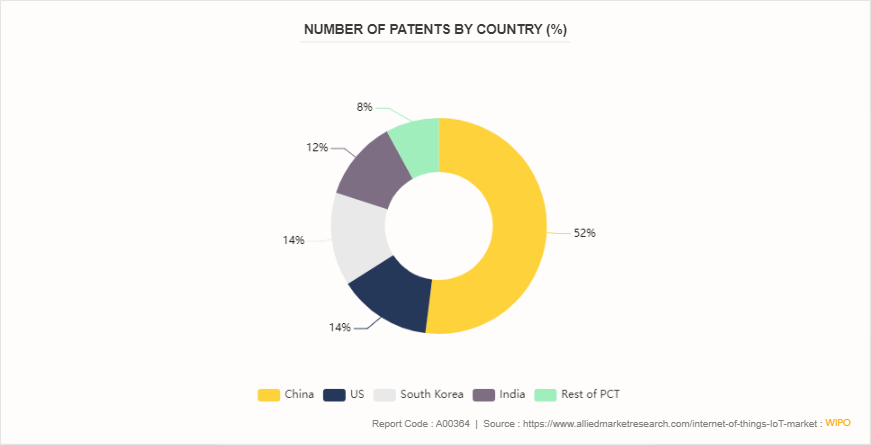IoT Market Insights, 2032
The global IoT market size was valued at USD 956.0 billion in 2023, and is projected to reach USD 5,332.3 billion by 2032, growing at a CAGR of 21.3% from 2024 to 2032.
The term Internet of Things (IoT) refers to the network that includes physical objects, also known as "things" that are integrated with sensors, software, and other technologies to communicate and share data with other internet-connected devices and systems. These devices range from household objects to sophisticated industrial tools. Now that users can connect everyday objects such as kitchen appliances, cars, thermostats, and baby monitors to the internet via embedded devices, seamless communication is possible between people, processes, and things.
The IoT market is expected to witness substantial growth during the forecast period. This is attributed to the reasons such as enhanced connectivity with 5G and LPWAN, reduced costs for devices and sensors, and progress in cloud and edge computing. In addition, the integration of AI and machine learning facilitates intelligent decision-making, while big data analytics assists companies in optimizing their operations, accelerating market growth. Furthermore, the rise in consumer interest in smart home devices and industrial IoT applications across fields like manufacturing and agriculture drives the growth of the global IoT market. Government efforts towards smart cities, coupled with better security and privacy measures, further fuels market growth.
However, the high initial costs of implementing IoT infrastructure, including sensors, connectivity, and data storage, can be a barrier, especially for small and medium-sized enterprises. In addition, the lack of standardization, which leads to interoperability issues between devices from different manufacturers, hampers market growth.
On the contrary, the IoT market is expected to offer numerous opportunities for new players in the market. In the consumer space, smart home solutions, including devices like thermostats, security cameras, and voice assistants, are in high demand as people seek convenience, energy savings, and enhanced security. In healthcare, IoT is revolutionizing patient care through wearable devices and remote monitoring systems, allowing for real-time health data analysis and more personalized treatments. Industrial IoT (IIoT) is also a major growth area, with applications like predictive maintenance, supply chain optimization, and manufacturing automation improving operational efficiency and reducing costs.

Key Takeaways
The internet of things market study covers 20 countries. The internet of things research includes a segment analysis of each country in terms of value ($Billion) for the projected period 2024-2032.
More than 1, 500 product literatures, industry releases, annual reports, and other such documents of major internet of things (IoT) market industry participants along with authentic industry journals, trade associations' releases, and government websites have been reviewed for generating high-value industry insights.
The study integrated high-quality data, professional opinions and analysis, and critical independent perspectives. The research approach is intended to provide a balanced view of global IoT market value and assist stakeholders in making educated decisions to achieve their most ambitious growth objectives.
Key Market Dynamics
The global IoT market demand has grown due to several factors such as the development of wireless networking technologies, the increase in cloud platform adoption, and the advent of advanced data analytics & data processing. However, the privacy and security concerns act as a restraint for the IoT industry expansion. In addition, the emergence of mobile devices is expected to provide ample opportunities for internet of things market expansion during the forecast period.
IoT Patent Analysis
IoT solutions, which integrate advanced network of interconnected devices, have seen significant patent activity across various regions. According to the World Intellectual Property Organization, in 2024, China leads in IoT solutions patents, driven by significant contributions from companies like Samsung Electronics Co. LTD, Chengdu Quinchuan IoT Tech Co Ltd. and others. U.S. also contributing to the internet of things market growth, focusing on adopting advanced technologies supported by government initiatives. While Korea and India encourage investments from global internet of things market players aiming to expand their technological capabilities.

Market Segmentation
The IoT market size is segmented on the basis of component, deployment mode, organization size, platform, technology, industry vertical, and region. By component, the market is divided into solution and service. Depending on deployment mode, it is segregated into on-premise and cloud. On the basis of organization size, it is bifurcated into large enterprises and small & medium size enterprises (SMEs) . As per the platform, it is fragmented into device management, application management, and network management. By technology, it is differentiated by radiofrequency identification, pressure sensors, network communications, data processing, and near-field communications. By industry vertical, it is categorized into retail, e-commerce, & consumer electronics, energy & utility, healthcare, transportation & logistics, IT & telecom, manufacturing, and others. Region-wise, the internet of thingsmarket is analyzed across North America, Europe, Asia-Pacific, Latin America, and Middle East and Africa.
On the basis of component, solutions & services are expected to dominate the market with the highest market share. Several industries are implementing intelligent solutions to improve their present systems. For instance, healthcare facilities deploy connected devices to improve medical outcomes.
Regional/Country Market Outlook
The global IoT market has experienced substantial growth, with North America playing a pivotal role in this expansion. North America leads the market, propelled by robust technological infrastructure, significant investments in smart technologies, and stringent safety regulations that encourage the integration of advanced IoT solutions. Europe follows closely, with countries such as Germany and the UK at the forefront, leveraging IoT solutions. In the Asia-Pacific region, rapid digitalization and increase in awareness of smart solutions drive the adoption of AI and IoT technology solutions, particularly in China and Japan, where government initiatives support technological advancements.
In April 2024, IBM, the Government of Canada, and the Government of Quebec announced agreements that strengthened Canada's semiconductor industry and further developed the assembly, testing, and packaging (ATP) capabilities for semiconductor modules to be used across a wide range of applications including telecommunications, high-performance computing, automotive, aerospace & defense, computer networks, and generative AI.
In June 2024, the General Services Administration (GSA) raised $80 million from the Inflation Reduction Act (IRA) , the largest climate investment in U.S. history, into smart building technologies that help reduce emissions, increase efficiency, decrease costs, and enhance comfort across an estimated 560 federal buildings.
Industry Trends:
In July 2023, the U.S. Government launched its long-awaited Internet of Things (IoT) cybersecurity labeling program that aims to protect Americans against the myriad security risks associated with internet-connected devices.
In May 2021, the Presidential Executive announced the improvement in the Nation’s Cybersecurity and directed NIST to initiate two labeling programs on cybersecurity capabilities of Internet-of-Things (IoT) consumer devices and software development practices.
Competitive Landscape
The major players operating in the IoT market share include Google LLC, Hewlett Packard Enterprise, Cisco Systems, Inc., International Business Machine Corporation (IBM) , SAP SE, Microsoft Corporation, Amazon Web Service., Oracle Corporation, Intel Corporation, and Bosch Software Innovation GMBH. These IoT leaders have adopted various strategies, such as product portfolio expansion, mergers & acquisitions, agreements, geographical expansion, and collaborations, to increase their market penetration and strengthen their foothold in the global IoT market.
Top Impacting Factors:
Integration of Artificial Intelligence (AI) and Machine Learning (ML)
The internet of things research highlights that the the integration of Artificial Intelligence (AI) and Machine Learning (ML) into the Internet of Things (IoT) market is driven by several key factors. The increase in the adoption of IoT devices has led to the generating of vast amounts of data, which AI and ML can process and analyze to derive actionable insights. This ability to process large data sets enables businesses to make more informed decisions, optimize operations, and enhance customer experiences in real-time. In addition, the rise in the need for automation in various industries, from manufacturing to healthcare, is accelerating the adoption of AI and ML in IoT systems. AI and ML algorithms can automate tasks, detect anomalies, predict failures, and optimize systems without human intervention, significantly increasing efficiency.
Furthermore, the surge in the demand for smarter, more adaptive IoT devices is a significant driver of AI and ML integration. By integrating AI and ML, these devices helps to learn from their environment, adapt to changing conditions, and improve over time, offering more personalized and intelligent solutions. In addition, the upsurge in the advancements in edge computing have enabled AI and ML to be processed closer to the source of data, reducing latency and bandwidth requirements. This enhances the overall performance and scalability of IoT systems, making the integration of AI and ML a crucial factor in the future of IoT technology.
Advanced Communication Technologies
The IoT market is expected to witness significant growth, driven by advancements in communication technologies. One of the primary drivers is the deployment of 5G networks, which offer ultra-low latency, high-speed connectivity, and the ability to handle a massive number of connected devices simultaneously. This makes IoT applications, such as smart cities, autonomous vehicles, and industrial automation, more feasible and efficient. In addition, the increase in the development of low-power wide-area networks (LPWAN), like LoRaWAN and NB-IoT, provides extended range and lower energy consumption, making them ideal for IoT devices that need to operate over long distances with minimal power, such as smart agriculture sensors and remote monitoring systems.
Furthermore, the surge in the integration of Wi-Fi 6 and Bluetooth Low Energy (BLE) contributes to the IoT market by improving connectivity in environments that require high-density device networks, like smart homes or healthcare facilities. In addition, the upsurge in the adoption of edge computing and cloud infrastructure are enabling real-time data processing and enhancing the scalability of IoT systems. Moreover, the rise of artificial intelligence (AI) and machine learning (ML) is driving smarter, data-driven decision-making in IoT systems, further increasing demand for advanced communication technologies to support these innovations. These technologies collectively enable the IoT ecosystem to scale, become more reliable, and support increasingly complex use cases.
Opportunity:
Development of smart cities and Urban Infrastructure
The development of smart cities and urban infrastructure offers numerous opportunities to enhance the quality of life for residents and promote sustainable growth. By integrating technology into urban planning, cities helps to become more efficient, environmentally friendly, and responsive to the needs of their citizens. One of the key opportunities lies in improving transportation systems. Smart cities helps to implement intelligent traffic management systems that reduce congestion, optimize routes, and lower emissions. The use of electric vehicles, shared mobility, and autonomous transport further reduces environmental impact and enhances mobility. In addition, smart infrastructure helps to provide better energy management. Through the use of sensors, smart grids, and renewable energy sources, cities can optimize energy consumption, reduce waste, and create greener environments. This leads to cost savings for both authorities and residents.
The development of smart cities also opens doors for enhanced public safety. Advanced surveillance systems, real-time data analytics, and predictive tools can help prevent crimes, monitor air quality, and provide timely disaster response. Moreover, integrating digital platforms enables efficient delivery of services like healthcare, education, and governance. In addition, the growth of smart cities encourages innovation and the creation of new industries, stimulating economic development, job creation, and long-term sustainability. The shift to smarter urban environments represents a transformative opportunity to shape the future of urban living. This is expected to offer considerable IoT market opportunity, as the demand for connected devices and technologies expands.
Market Trends
Adoption of Blockchain Technologies
The adoption of blockchain technologies in the IoT market is gaining momentum, driven by the increase in the demand for enhanced security, transparency, and scalability in connected devices. Blockchain, with its decentralized and tamper-proof nature, offers a robust solution to some of the key challenges IoT faces, such as data integrity, device authentication, and trust management. One of the prominent trends is the integration of blockchain to create secure, peer-to-peer communication networks among IoT devices, reducing the reliance on centralized servers and enhancing data privacy. This enables devices to interact autonomously and securely, minimizing the risk of cyberattacks. In addition, blockchain’s immutability ensures that data generated by IoT devices is recorded in a transparent and verifiable manner, making it easier to trace and audit data exchanges.
Another notable trend in the market is the development of smart contracts that automate transactions and operations within IoT ecosystems. Smart contracts reduce the need for intermediaries, streamline processes, and ensure compliance, offering businesses more efficient and cost-effective IoT solutions. In addition, there is a growing trend in the adoption of blockchain technology which enables decentralized identity management, transforming the way devices are authenticated, mitigating risks associated with identity theft and unauthorized access. As industries like supply chain, healthcare, and manufacturing continue to embrace IoT, the adoption of blockchain technology is expected to grow, offering new opportunities for innovation and efficiency.
Recent Key Strategies and Developments
In February 2024, Digi International Inc. launched Digi IX40, a 5G edge computing industrial IoT cellular router solution. Digi IX40 is purpose-built for Industry 4.0 use cases such as advanced robotics, predictive maintenance, asset monitoring, industrial automation, and smart manufacturing.
In February 2023, KORE launched its recent technology software MODGo, which provides a unified, digital approach to IoT asset management, at the Mobile World Congress Barcelona. This cutting-edge solution provides a streamlined approach to managed services, designed to help organizations overcome the challenges of IoT implementation and management.
In March 2023, the Ministry of Electronics and Information Technology (MeitY) launched three IoT sensor-based products, which include a “Smart Digital thermometer”, “IoT enabled Environmental Monitoring System” and “Multichannel data Acquisition System”, developed by C-MET in the CoE in IIoT sensors.
Recent Partnerships in the Industry
- On March 20, 2025, Thales partnered with Wireless Logic as its IoT partner to enable secure, scalable, and resilient IoT connectivity across diverse regions globally. This partnership integrates Thales' advanced GSMA SGP.32-based eSIM solution, Adaptive Connect, with Wireless Logic's carrier-grade IoT network, Conexa. This integration aims to provide seamless IoT connectivity management, allowing Thales' customers to deploy and manage IoT fleets globally with an effortless "out of the box" experience. The collaboration leverages partnerships with leading mobile network operators to enhance IoT deployment flexibility and ensure secure, reliable performance on a global scale.
- On January 27, 2025, TP-Link partnered with Optiemus Electronics to manufacture telecom and IoT devices in India. This strategic collaboration aims to meet the growing demand for connected devices in India and support the 'Make in India' initiative. Optiemus Electronics helps to produce a range of TP-Link's networking devices and smart home products, including Wi-Fi routers, modems, and security cameras. This partnership is expected to boost local manufacturing, create job opportunities, and reduce import dependencies.
Key Sources Referred
Ministry of Electronics & IT
Internet Society
IEEE
CSA IoT
Key Benefits for Stakeholders
This report provides a quantitative analysis of the IoT market forecast segments, current trends, estimations, and dynamics of the IoT market analysis from 2023 to 2032 to identify the prevailing IoT market opportunities.
Market research is offered along with information related to key drivers, restraints, and opportunities.
Porter's five forces analysis highlights the potency of buyers and suppliers to enable stakeholders to make profit-oriented business decisions and strengthen their supplier-buyer network.
In-depth analysis of the IoT market segmentation assists in determining the prevailing market opportunities.
Major countries in each region are mapped according to their revenue contribution to the global IoT market Statistics.
Market player positioning facilitates benchmarking and provides a clear understanding of the present position of the market players.
The report includes the analysis of the regional and global IoT market trends, key players, market segments, application areas, and market growth strategies.
IoT Market Report Highlights
| Aspects | Details |
| Market Size By 2032 | USD 5332.3 Billion |
| Growth Rate | CAGR of 21.3% |
| Forecast period | 2024 - 2032 |
| Report Pages | 350 |
| By Component |
|
| By Deployment Mode |
|
| By Organization Size |
|
| By Platform |
|
| By Technology |
|
| By Industry Vertical |
|
| By Region |
|
| Key Market Players | Cisco Systems, Inc., Hewlett Packard Enterprise, International Business Machine Corporation (IBM), Google LLC, Oracle Corporation, Intel Corporation, Bosch Software Innovation GMBH, SAP SE, Amazon Web Service, Microsoft Corporation |
The global IoT market size was valued at USD 956.0 billion in 2023, and is projected to reach USD 5,332.3 billion by 2032
The global IoT market is projected to grow at a compound annual growth rate of 21.3% from 2024-2032 to reach USD 5,332.3 billion by 2032
The key players profiled in the reports includes Google LLC, Hewlett Packard Enterprise, Cisco Systems, Inc., International Business Machine Corporation (IBM), SAP SE, Microsoft Corporation, Amazon Web Service., Oracle Corporation, Intel Corporation, and Bosch Software Innovation GMBH.
North America is the largest regional market for IoT as of 2023.
Loading Table Of Content...


